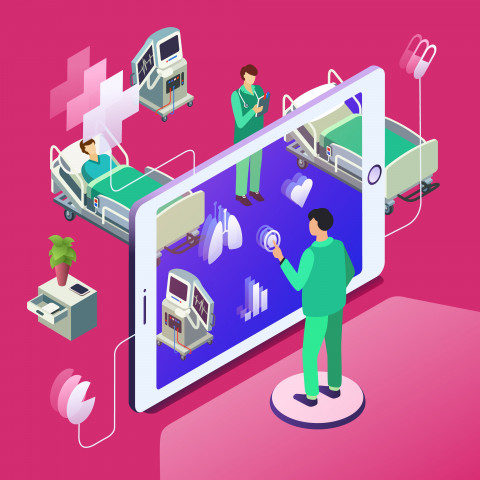Healthcare innovation, powered by AI
Human Centred Design Thinking with AI, sought to leverage cutting edge tools and approaches to solve clinical problems

Traditional healthcare systems and conventional learning processes have been in place in
Pakistan since the very beginning. Despite their longstanding presence, both have seen little
in terms of innovation and progress.
What if the recent technological breakthroughs could be integrated into our healthcare system, transforming the way it operates and delivers services?
Imagine if these cutting-edge tools and techniques could empower our healthcare professionals to acquire new skills and methods to save lives more effectively.
In an effort to tackle healthcare challenges through technology, AIM Consulting organised a two-day healthcare summit in collaboration with Aga Khan University Hospital. The primary goal was to digitise, foster innovation, apply design thinking, leverage emerging technologies, and revolutionise the entire healthcare system.
The master class at the summit focused on combining Human Centred Design Thinking (HCDT) – an effective
method for resolving challenging issues – with Artificial Intelligence (AI) to resolve clinical
problems.
“Combining the two works well in the age of generative AI,” said Dr Asad Mian, Director of CCIT Forum and Professor of Emergency Medicine at AKU. “We applied HCDT and generative AI together to a clinical problem in this master class, under an idea we have named ‘Create 2 innovate’ (C2i),” he explained.
The main idea behind enhancing learning and design thinking encompasses five key aspects that the workshop participants explored: empathise, define, ideation, prototyping, and testing. In the first phase, ‘empathise’, participants delve into understanding clinical issues from various perspectives, including those of patients and healthcare practitioners. This involves group discussions to explore diverse viewpoints.
Moving on to the ‘define’ stage, participants use acquired knowledge to articulate the problem clearly, engaging in collaborative efforts to refine the problem description. The third phase, ‘ideation’, involves employing generative AI as a brainstorming tool to generate original solutions, with teams visualising and developing concepts using this technology.
In the ‘prototyping’ stage, participants create concrete concepts or models for the proposed solutions, collaborating with AI technologies to sketch out prototypes. Finally, in the ‘testing’ stage, the solutions are evaluated, and revisions are made based on feedback. This includes showcasing prototypes to the group for improvement and comments, completing
the iterative design process.
The C2i concept involves AI-powered storytelling, elaborating a given scenario or medical problem in a way that allows even a layperson to not only comprehend it but offer initial treatment or manage the medical emergency.
AI-generated storytelling is a two-step process; shared Dr Mian. In the introduction phase, the scene is set, and a real-world clinical problem is described. For example, children experiencing an exacerbation of asthma being presented to the emergency room. The second step involves engagement to enhance the storytelling element, utilising generative AI to generate scenarios and visual representations, he added.
According to Dr Mian, C2i is not a novel concept. It has been employed in various scenarios to empower innovative teaching and learning. An example he shared was of the ‘Biloongra’ blog, where the titular character has been created to educate high school students about health literacy using innovative tools.
The motivation behind creating such content is to educate non-medical individuals on how to respond to an emergency in the absence of immediate medical assistance. While recognising that not every case can be managed by a layperson, disseminating basic knowledge of initial treatment is crucial. Initiatives like these can contribute to saving more
lives lost due to uninformed individuals.
Such awareness campaigns also prove valuable in emergency departments during times of crisis, explained the Professor of Emergency Medicine at AKU.
Through this practice and the master class, the generated content aims to address and utilise diverse approaches, essentially working at the intersection of various disciplines. The activity is designed to underscore the significance of HCDT in addressing complex clinical issues, in conjunction with fostering creativity, innovation, and cross-disciplinary
teamwork, said Dr Mian.
He added that it also highlights the transformative potential of regenerative AI in the healthcare industry. The creative and innovative workshop serves as a platform for participants to hone their storytelling skills within the context of clinical scenarios. It also provides valuable insights into HCDT and generative AI, showcasing their potential applications in healthcare. For instance, if a respiratory emergency is the chosen case, the initial steps involve empathising with the client/patient and assessing the severity of the problem.
Subsequently, defining the problem and conducting necessary analysis follow. After defining, the ideation process begins, where a solution is generated through divergent and design thinking. The main phase involves prototyping and utilising AI tools to craft the story and create illustrations that address the patient's problem. Finally, the solution undergoes testing to ensure its efficacy and comprehensibility for laypersons.
To create a connected set of illustrations, consistent characters were employed, allowing stories to be related with various ideas and issues. Dr Mian said awareness workshops have been also been conducted, and several more are in the pipeline, each spanning three to five days.
These workshops accommodate over 50 participants per class, organised into groups
of four to five participants each.



















COMMENTS
Comments are moderated and generally will be posted if they are on-topic and not abusive.
For more information, please see our Comments FAQ